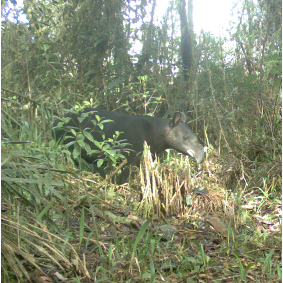New photographs reveal the presence of the mountain tapir in southern Sangay National Park, Ecuador
 |
||
The mountain tapir is photo-captured in montane forest at 3,000 meters (9,800 feet) on private property in Ecuador’s Cañar Province. |
Cuenca, Ecuador (25 November 2014) - Fundación Cordillera Tropical reports the presence of the critically endangered mountain tapir (Tapirus pinchaque) in southern Sangay National Park. The species had all but disappeared according to local residents, who nevertheless confirm its historical presence. Five series of photographs obtained between 2013 and 2014 suggest that the region hosts some of only 2,500 individuals worldwide.
Over the past 24 months, Fundación Cordillera Tropical and Ph.D. candidate Becky Zug from the University of Wisconsin-Madison, U.S.A., have used motion-sensor ¨camera traps¨ to study the habitat use of the Andean bear and associated wildlife on private property within and adjacent to Sangay National Park. ¨Following years of study with camera traps in this region, we are very surprised to finally photo-capture the mountain tapir,¨ comments Catherine Schloegel, Executive Director. ¨These findings highlight the critical role that private lands play in the protection of endangered species¨.
Ecuadorian scientists predict mountain tapir presence in the remote wilderness found in central Sangay National Park. With these recent photo-captures, Fundación Cordillera Tropical presents evidence that the mountain tapir resides on private property in southern Sangay where it must confront people and their property. The mountain tapir photo-capture sites have been less than 200 meters (650 feet) from communities and new infrastructure construction sites.
Locally the mountain tapir is known as the “gran bestia” or ¨the great beast¨ and it is one of the largest, most threatened mammals in the world with only 2,500 individuals found in all of its range. Presently, it is found in Colombia, Ecuador, and Peru. In Ecuador, deforestation and hunting are the two principle threats to the survival of this species. As a consequence, the mountain tapir is one of twenty critically endangered species according to the Ecuadorian Red List and scientists predict its extinction in the next three generations.
 |
|
The mountain tapir is the only member of the Tapiridae family that lives exclusively in the Andes and is typically found between 2,300 - 4,300 meters (7,500 – 14,100 feet) above sea level. An average mountain tapir weighs 150 kilos (330 lbs) and is 1.8 meters (6 feet) long and is easily recognized by its long snout. It is an herbivore and consumes leaves, branches, and wild fruits found in the forest and páramo, making it an important seed disperser. Both the mountain lion, or puma, and Andean bear prey on the tapir.
Experts suggest that habitat protection is the most important measure to ensure mountain tapir conservation. In Ecuador, Sangay National Park is one of the last refuges where this species is found. Our current results demand collaboration between different state institutions charged with conservation and development to assure the protection of the last refuges of mountain tapir habitat.
These photo-captures form part of the Don Oso Program, an initiative of Fundación Cordillera Tropical to conserve the Andean bear and its habitat. The Don Oso Program receives generous financial support from the University of Wisconsin-Madison and Disney Worldwide Conservation Fund. The collaboration of the Ministry of Environment, the corps of community park guards, and an extremely dedicated group of local property owners and conservationists made this work possible.
Written by Paola Andrea Girón O.
